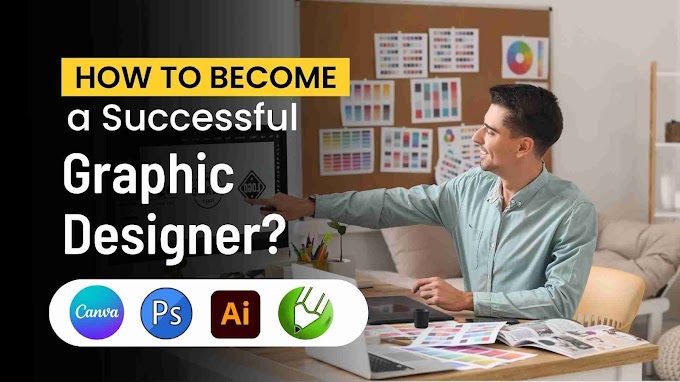In the digital age, visual communication has become more critical than ever.
From beautiful logos to stunning website designs, graphic designers play a pivotal role in creating visually appealing and impactful content.
If you have a passion for creativity and aesthetics, embarking on a career as a graphics designer might be the perfect fit for you.
In this article, we will delve into the vast scope of graphic designing and provide you with a step-by-step guide on how to become a graphics designer.
To become a graphic designer, you can follow these steps:
1. Develop your skills and knowledge:
Start by gaining a strong foundation in graphic design principles and techniques.
Learn about composition, typography, color theory, and layout design. Familiarize yourself with industry-standard software such as Adobe Photoshop, Illustrator, and InDesign.
You can learn these skills through online tutorials, classes, workshops, or self-study using books and online resources.
2. Pursue formal education:
While a formal education is not mandatory, it can provide you with a comprehensive understanding of graphic design and give you an advantage in the competitive job market.
Consider enrolling in a graphic design program at a university, college, or specialized design school.
These programs offer structured learning, access to industry professionals, and opportunities for networking.
3. Build a portfolio:
A portfolio is crucial for showcasing your skills and attracting potential clients or employers.
Start by working on personal projects or offering your services to friends, family, or local businesses. Focus on creating a diverse range of design work that demonstrates your creativity and technical abilities.
Continually update and refine your portfolio as you gain more experience and develop new skills.
4. Gain practical experience:
Look for internships, freelance opportunities, or entry-level positions that allow you to apply your skills in a professional setting.
Practical experience will help you understand client requirements, work within deadlines, and collaborate with others.
It will also provide you with valuable industry connections and references for future opportunities.
5. Stay updated and network:
Graphic design is a constantly evolving field, so it's essential to stay updated with current trends, tools, and techniques.
Follow design blogs, participate in online communities, and attend design conferences, workshops, or networking events.
Building a strong professional network can lead to new opportunities, collaborations, and mentorship.
Additionally, continuously practice and seek feedback on your work to improve your skills.
Be open to learning from others and experimenting with different design styles and projects.
Developing a strong work ethic, creativity, and a passion for design will contribute to your success as a graphic designer.
FAQs:
Q1. What is graphic designing?
Ans: Graphic designing is the art and practice of creating visual content using typography, images, and other design elements.
It involves creating visually appealing and impactful designs for various mediums such as print, digital media, advertising, and branding.
Q2. What is the scope of graphic designing in today's digital world?
Ans: The scope of graphic designing is vast and ever-expanding.
It encompasses diverse industries such as advertising, marketing, web design, branding, packaging, user interface (UI) design, motion graphics, and more.
Graphic designers are in demand to create visually compelling content for both online and offline platforms.
Q3. What skills are essential to become a graphic designer?
Ans: Key skills for graphic designers include proficiency in design software (such as Adobe Creative Suite), a strong sense of aesthetics, an understanding of color theory, typography skills, creativity, problem-solving ability, and effective communication skills.
Q4. Do I need a formal education in graphic design to become a graphic designer?
Ans: While formal education in graphic design can be beneficial, it is not mandatory.
Many successful graphic designers have honed their skills through self-study, online tutorials, workshops, and practical experience.
Building a strong portfolio showcasing your work is crucial regardless of your educational background.
Q5. How can I develop my design skills and stay updated with current trends?
Ans: Developing your design skills involves continuous learning and staying inspired.
You can explore design blogs, attend design conferences and workshops, follow influential designers on social media, participate in design competitions, and take advantage of online design resources and courses.
Q6. How can I gain practical experience as a graphic designer?
Ans: Practical experience is invaluable in the field of graphic design. You can gain experience by taking on freelance projects, internships, or volunteering to work on design tasks for local businesses, nonprofits, or community projects.
Building a diverse portfolio is essential to showcase your range of skills and projects.
Q7. What are the essential design tools and software for graphic designers?
Ans: Graphic designers commonly use design software such as Adobe Photoshop, Illustrator, and InDesign.
These tools offer a wide range of capabilities for creating and manipulating images, illustrations, and layouts. It's important to stay updated with the latest features and techniques of these software programs.
Q8. How can I start my career as a graphic designer?
Ans: To start your career as a graphic designer, begin by building a strong portfolio showcasing your best design work.
Utilize online platforms and job boards to search for entry-level positions, internships, or freelance opportunities.
Networking with professionals in the industry can also lead to valuable connections and job opportunities.
Q9. What are the different career paths for graphic designers?
Ans: Graphic designers can pursue various career paths, including working as in-house designers for companies, joining design agencies, freelancing, or even starting their own design studio.
Some designers specialize in specific areas such as web design, UI/UX design, branding, or motion graphics.
Q10. How can I keep growing as a graphic designer and stay relevant in the industry?
Ans: Continuous growth as a graphic designer involves learning new design techniques, staying updated with industry trends, and expanding your skill set.
Engage in professional development opportunities, attend workshops, obtain relevant certifications, and seek feedback from peers and mentors to enhance your skills and stay ahead in the field.
![Unitcell Education [Learn Something New Everyday]](https://blogger.googleusercontent.com/img/b/R29vZ2xl/AVvXsEinsT2Q2YmA-Lx6iY0ooOsw40uCwyZViq9ZxVk9q4Ug-R8D8Xh3oGFD6Ks79h6SY0Xc70erN6SK0UY1-UjE4lAkNwFLs1Wt9xnxkkyLGlFCWnaLZhAk2XYij6-dPM1oixGmhLfefGSZH64/s880/unitcell+education+logo+2022.png)




0 Comments